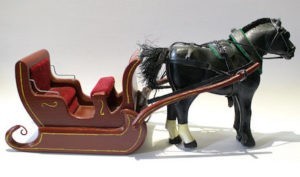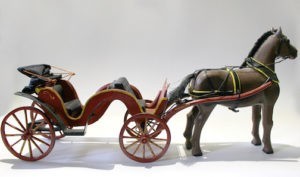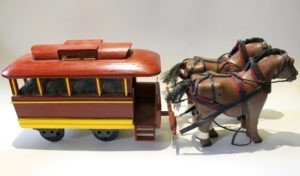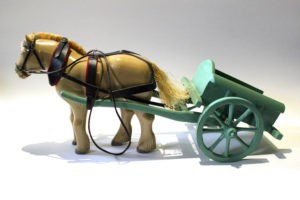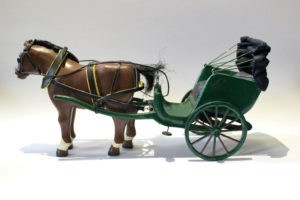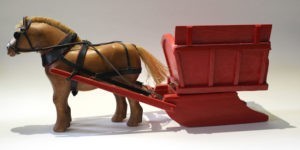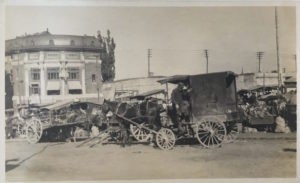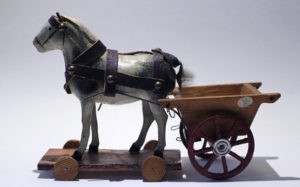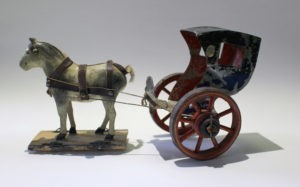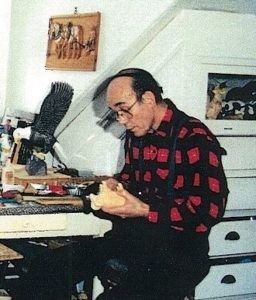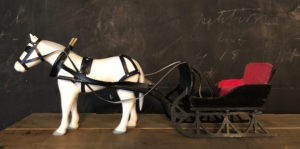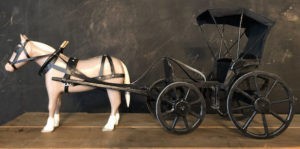The painted wooden sculptures in the exhibit are the work of Nova Scotia-born folk artist Ernest Muise (1928–1996). He was the last live-in caretaker in the Morrin Centre building, and also looked after the properties of St. Andrew’s Church. Between 1975 and 1989, he lived on the ground floor of the Morrin Centre with his family.
Muise’s sculptures of horse-drawn vehicles depict some of the various types of transportation available in Quebec City in the late 19th and early 20th century: the cart, the buggy, the berline, the sleigh/cariole, the Victoria/barouche, and the tramway. Horse-drawn tramways, ancestors to our public buses, first appeared in Quebec City in 1863, and circulated on wooden rails; they disappeared with the advent of the electric tram in 1897. Horse-drawn vehicles for personal use could still be seen in the city until the 1950s, but they are now used solely for leisure rides for tourists.
Although Muise’s sculptures were not intended as toys for children, the two 19th-century miniature horse-drawn vehicles in our collection were. They belonged to the Rickaby children, and were played with by boys and girls alike. The Rickabys set up shop on rue Saint-Jean in the early 19th century and remained there until the 1970s. By the early 20th century, the shop was listed as a “manufacturer of furniture, wire mattresses, office desks, upholsterer, and undertaker.”
Unlike the majority of the toys in our collection, these vehicles were more commonly considered as playthings for boys. They were the dump trucks and toy cars of bygone generations
-
HORSE-DRAWN SLEIGH
Ernest Muise, 1990s, Quebec City
Wood, leather, velvet, metal, and fibres
Muise Collection 2004-157
16.5 x 36 x 12 cm
-
HORSE-DRAWN VICTORIA
Ernest Muise, 1990s, Quebec City
Wood, plastic, leather, metal, fibres, fabric, and vinyl
Muise Collection 2004-161
21.9 x 56 x 12.1 cm
-
HORSE-DRAWN TRAMWAY
Ernest Muise, 1990s, Quebec City
Wood, plastic, leather, velvet, metal, and fibres
Muise Collection 2004-156
16.5 x 45 x 15 cm
-
HORSE-DRAWN BUGGY
Ernest Muise, 1990s, Quebec City
Wood, leather, fibres, velvet, and metal
Muise Collection 2004-155
15.3 x 33 x 12 cm
-
HORSE-DRAWN CARRIAGE
Ernest Muise, 1990s, Quebec City
Wood, plastic, fabric, leather, vinyl, and fibres
Muise Collection 2004-158
13 x 33.5 x 11 cm
-
HORSE-DRAWN CARRIAGE
Ernest Muise, 1990s, Quebec City
Wood, leather, metal, fibres, and velvet
Muise Collection 2004-160
-
PLACE D’YOUVILLE
BAnQ-Q, P450, 2009-03-006/53
-
TOY HORSE-DRAWN CART
c. 1880, unknown origin
Wood, leather, fur, metal, and string
Belonged to the Rickaby family
Stephens Collection 2004-183
14.7 x 6 x 20 cm
-
TOY HORSE-DRAWN CAB
c. 1880, unknown origin
Wood, leather, fur, metal, and string
Belonged to the Rickaby family
Stephens Collection 2004-184
14.3 x 26 x 10.3 cm
-
ERNEST MUISE AT WORK
Quebec City, 1990s
Muise Family Collection
-
HORSE-DRAWN SLEIGH
Ernest Muise, 1990s, Quebec City
Wood, vinyl, velvet, and polyester fleece
Muise Collection 2004-159
20.7 x 54.5 x 12.5 cm
-
HORSE-DRAWN BUGGY
Ernest Muise, 1990s, Quebec City
Wood, metal, plastic, fabric, vinyl, and velvet
Muise Collection 2004-154
28 x 60.5 x 17 cm
Excerpts from writings by Mary Hilda Freeland Stephens:
“I remember waking up in the morning hearing the horses trotting along Cook Street, the milk being delivered, and in the winter the horse-drawn Berlins (great box-like sleighs painted red or blue or green) being filled with snow by the men shovelling.” (Mary Hilda Freeland Stephens, Remembering a Quebec Childhood, 2)
